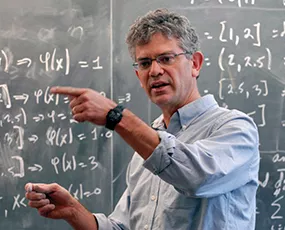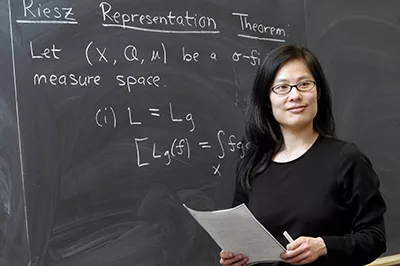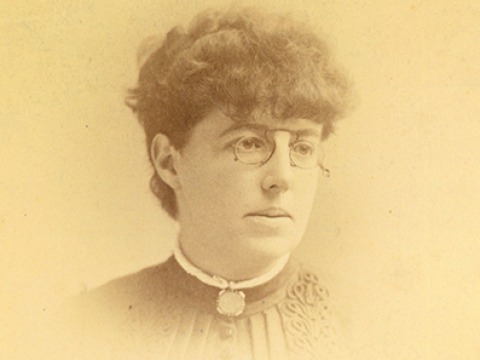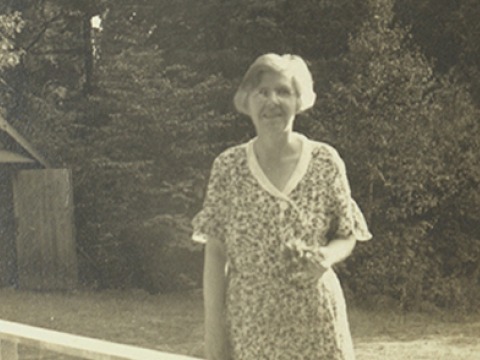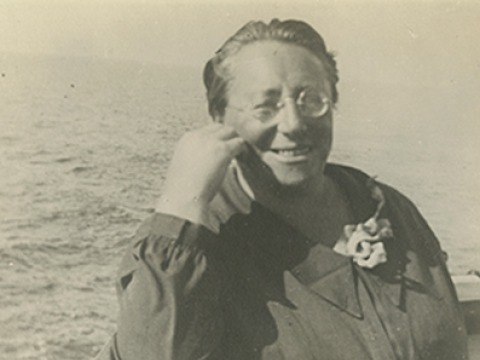
Where Math Rules
Math is a popular major at Bryn Mawr. The department’s open and welcoming philosophy helps explain why it all adds up for so many students.
When students sign up to major in math at Bryn Mawr, they receive a goody bag to welcome them into the department. Along with a sticker and a pen, the packet includes a candy bar whose smart blue wrapper is emblazoned with the slogan “It’s not π, but it’s still pretty sweet!”
In recent years, more and more Bryn Mawr students have been snapping up those candy bars. Math is one of the College’s most popular majors, and Bryn Mawr claims 11 times the national average of women graduating with an undergraduate degree in math. In 2012, the department received the American Mathematical Society’s Award for an Exemplary Program or Achievement in a Mathematics Department.
The citation reads, in part: “The math department at Bryn Mawr has a long history of encouraging women to pursue careers in mathematics and, more generally, of providing women with an environment in which they may thrive in this pursuit.”
A sense of belonging
on the William R. Kenan Jr., Chair,
Victor Donnay
One of the keys to the department’s success has been its ability to make students feel they belong. The department strenuously rebuffs the notion that math is an elitist pursuit, says Professor and Chair of Mathematics on the William R. Kenan Jr., Chair, Victor Donnay. “There’s this misconception,” he says, “that it can only be done by certain genius types who are innately talented and born with that skill.”
Women in particular, Donnay says, have often had bad experiences with math and been made to feel that this is a male field. “So, we need to give students a fresh start in math and let them know that we expect them to be able to succeed, that they’re talented, and that we’re happy to do the work to support them to be successful.”
Senior lecturers Amy Myers and Peter Kasius and Visiting Instructor Daisy Sudparid, who teach the introductory courses, play a key role, Donnay says, in welcoming students into the math community and encouraging them to continue with further math study. The department uses the term “vertical integration” to describe the intentional links from the early stages of the program through the mid-level courses and connecting to the upper-level and graduate courses.
Projecting an inclusive stance from the get-go is an integral part of Bryn Mawr math culture, says Professor of Mathematics and Class of 1897 Professor of Science Lisa Traynor. “There are so many schools where the attitude is, ‘We have to be sure these students know that they’re not good enough to go on to graduate school.’ We’ve always had a more open attitude where it’s like, if students want to do this, let’s help them do it.”
In Traynor’s introductory classes, students spend time discussing living mathematicians so they can connect to its human element. One resource used is the website Mathematically Gifted and Black (MGB) that was co-developed by Erica Graham ‘04, associate professor of mathematics. MGB showcases Black mathematicians talking about their lives and accomplishments.
The department’s broad philosophy of nurture and support can be traced back to an earlier generation of math faculty that included Rhonda Hughes, the Helen Herrmann Professor Emeritus of Mathematics. When Hughes arrived at Bryn Mawr in 1980, there were just two or three math majors per year. Hughes and her colleagues, including Professor of Mathematics Paul Melvin, worked hard to make the program more approachable and inclusive, and the number began to steadily rise. That trajectory has continued to the point where currently around 40 Bryn Mawr students major in math every year.
Leslie Cheng ’92, Rachel C. Hale Professor in the Sciences and Mathematics, knows she would never have become a math major without Hughes’ encouragement. In high school, Cheng had failed calculus and hated math. Arriving at Bryn Mawr as an undergraduate, she was determined to take the easiest math class available to fulfill the quantitative requirement. Cheng told Hughes that she “just wanted to get this over with,” but Hughes persuaded her that calculus would be different in college and she should give it a try. Cheng sat in on the class and found she understood everything— and even enjoyed it. She went on take Calculus II, and when Hughes said, “Why don’t you major in math?” she followed her suggestion, going on to earn her doctorate at the University of Pittsburgh and returning to Bryn Mawr in 2002 for her first tenure-track teaching position.
Math as a springboard
Not every math major follows Cheng’s path to graduate school or academia, but as Donnay points out, “math is a very useful tool in the world,” and having a degree in math can open many career doors. “Companies are eager to have students with strong math skills,” he says. “The company can teach them the nitty gritty of the particular job or industry, but this overall quantitative sense, being comfortable with numbers and abstract reasoning, that’s not so easily taught. When they interview our students, they find they have they great communication skills, but there’s also this extra bonus of the math skills.”
“Our majors go on to do a variety of different things, some directly related to math and others not,” Cheng adds. “But they always come back and tell us it was useful to have a math major because it taught them how to think logically and problem solve.” Traynor says that students naturally see a connection between studying math and working in business or finance, but she also knows many graduates who have applied their quantitative skills to solving problems in medicine or pursuing careers in government, teaching or consulting. “There’s just so many different directions you can go in,” she says.
While most of the faculty are theoretical mathematicians, some, like Erica Graham, focus on applied mathematics, and others offer classes that make a direct connection to the real world. Graham, who works in mathematical biology, teaches courses on math modeling and mathematical biology. Cheng, though her research area of harmonic analysis is more abstract, has developed popular courses on mathematical finance that give students interested in economics and business a window into how math is used on Wall Street. Donnay teaches a course on math modeling and sustainability, showing how math can be used to analyze issues of sustainability and climate change.
The College is also developing a data science minor, and the math department hopes to soon have the opportunity to hire a statistician. “That’s a clear, very interdisciplinary area that math has a role to play in,” Donnay says. “And related to that, we’re also working to include more computing in our courses.”
Making math fun
The department has worked to build a culture where students come together socially around their academics, introducing a sense of play and community while cultivating a network of like-minded peers.
Activities include a weekly problem-solving seminar with Senior Lecturer Peter Kasius and the Distressing Math Collective (DMC), a forum originally founded by Professor Emeritus Helen Grundman for discussing particularly weird and quirky mathematical paradoxes and topics not usually covered in math courses. The informal and relaxed meetings, which are organized by a team of students, consist of a math talk, often given by an undergraduate math major or an alum, followed by a lively and irreverent session of math-oriented game playing.
An issue of social justice
Beyond the fun and games, Donnay sees quantitative literacy as a social justice issue. A math education, he argues, gives people access to a myriad of opportunities in society that depend on having a strong STEM background and is one of the basic skills that educated people need to make sense of the world.
Discrepancies in math preparation are all too real, says Donnay, who teaches a course on math and science education and works with teachers in the Philadelphia area. Over the last decade, he says, “responding to the fact that with the inequities in our society students who were at schools that had weak math programs start with less preparation, we’ve been making concentrated efforts to support them in making the transition to be successful in math.”
One approach to helping students who come from under-resourced schools do well in Bryn Mawr’s math classes is the “flipped classroom” model used by both Traynor and Myers, where students watch a recorded lecture at their own pace before class and then gather to work on problems together. “This way I can spend more time going through background,” says Traynor, who embraced this way of teaching during the pandemic. “And then during class, I make up a worksheet and they just work on the problems.”
The Posse program, which brings 10 scholars from Houston and Boston to Bryn Mawr each year to study STEM, also seeks to address societal inequities in education, with several math faculty, including Cheng, Amy Myers, and Sudparid, acting as Posse mentors.
The department’s small graduate program, led by Associate Professor Djordje Milićević, with seven or eight students at any one point working toward a Ph.D., further benefits undergraduates in the program, since doctoral students serve as teaching assistants and work with undergraduates, individually and in groups, acting as both mentors and role models.
Ongoing support after graduation exists, too, in the form of the EDGE program, launched independently by Hughes, that prepares women and minority students for graduate-level mathematics during the summer between college and graduate school. The program, which has won national awards, has been successful in increasing the number of students from under represented groups and women earning Ph.D.s and going on to careers in academia. Ziva Myer, a visiting assistant professor in the department, earned her math Ph.D. at Bryn Mawr and was part of EDGE. Graham also went through the program and has been involved as a mentor.
A learning process
As welcoming and supportive as the math culture is at Bryn Mawr, Donnay says, it is “not all rosy,” and room for improvement exists. A department climate survey conducted last year revealed that while many students felt very welcomed and at home, others‚ primarily Black and brown first-generation students, still felt on the outside.
“So, we continue to work at ways to make all of the students feel at home in the department,” Donnay says. “You do your best work when you’re able to think freely, and all these other voices—Do I belong? Am I smart enough?—just get in the way of being able to fulfill your potential. We’re not coddling students by trying to make a yet more welcoming atmosphere, we’re trying to let them perform
up to their true potential.”
Also in response to the climate survey, the department has recently rethought its math major requirements. Survey respondents had mentioned feeling that pure math garnered more attention and respect than applied math. The requirements now can be fulfilled by doing a mix of both pure and applied math.
Keeping up the challenge
Another issue faced by a department with students at a wide range of levels is keeping the program challenging enough for those coming in with stronger preparation. One way this is addressed is through Bryn Mawr’s joint A.B./M.A. program, where advanced students can get both their bachelor’s and master’s degrees in four years. Undergraduates not pursuing the A.B./M.A. also have the opportunity to take graduate courses.
“Right now, I’m teaching a differential topology class,” says Traynor. “There are five students in it. Two of them are full-time graduate students, two of them are A.B./M.A. students, and one is an undergrad who just wants to take graduate courses. For a student who is thinking about maybe going to grad school in math, it’s nice to see the more intense courses that happen at that level.”
The department’s newest member, Assistant Professor John Bergdall, who has supervised students in the A.B./M.A. program and summer math researchers, says, “The student researchers, regardless of their steps after Bryn Mawr, always tell me their projects helped them think more clearly and patiently about complex and long-term problems and appreciate more fully the challenge of clearly communicating solutions.”
Whether a Bryn Mawr math major goes on to graduate school or chooses another option, when they leave campus, “they know that they have finished a degree in math,” Traynor says. “They can say, ‘I majored in math.’ And that is not an easy thing to do.”
Published on: 02/23/2022
